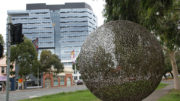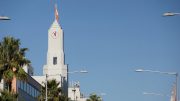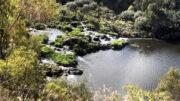The Bow Truss Building, a world renowned cement pillar less building with expansive concrete roof once stood in Brougham Street where the modern steel and glass TAC Building stands today.

The building was designed by Edward Giles Stone a civil engineer who pushed design boundaries with reinforced concrete in the early 1900’s. The Barwon Sewer Aqueduct in Breakwater and the Dennys Lascelles Austin Bow Truss Woolstore are two of his most celebrated engineering achievements.
Formally known as the Dennys Lascelles Wool Stores, the Bow Truss Building was a major extension to the building that was built some four decades earlier that is now known as the National Wool Museum.
The bow truss building saw huge clear space under a massive 55 x 52 metre, nearly an acre of concrete roofspan, making it the largest reinforced concrete roof in the world. The design was based on bridge design with sawtooth roof trusses passing through the giant curved concrete structures allowing for abundant natural light. The facades of the building were rendered in Art Nouveau style.
The site was considered very unique and was listed on several heritage registers including the Register of National Estate and National Trust register. The building was even nominated for a world heritage listing that was supported by several international referees.
In the late 1980’s Geelong’s rejuvenation was well underway, the woolstores were moving away from the waterfront to new modern facilities and the town was transforming. The City by the Bay concept starting to take off and the then potential of the nearly abandoned waterfront starting to look promising.
The heritage overlays and the cost of upkeep on the bow truss building that was sitting idle vs the potential of prime real estate brought much controversy to the site. Scaffolding was built around the structure that not only disrupted parking and traffic flow around the city, this also helped reinforce the unsafe and unsightly message into Geelong resident’s minds.
In May of 1990 the building was destroyed after the State Government of Victoria intervened to override the state’s heritage body on its significance. The building was declared unstable and unsafe, only problem was it was so strong it was nearly impossible to destroy.
The real estate then became a carpark for over close to twenty years before the TAC building was erected on the site.
The lasting legacy of the Bow Truss is our city and people now have placed a higher value on our history and heritage. Hopefully we won’t repeat the mistakes of our past, as once it’s gone we can never bring it back.




